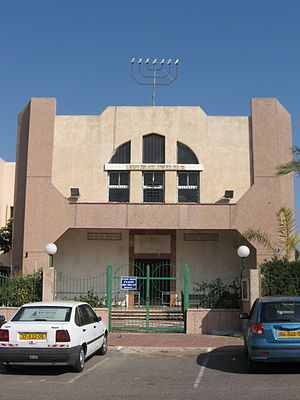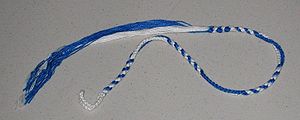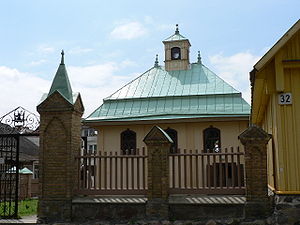Karaites
Karaite Judaism or Karaism is a Jewish movement characterized by the predominant reliance on the Tanakh as scripture and the rejection of the Oral Law of rabbinic Judaism.
The word "Karaite" comes from the Hebrew word קָרָאִים (Standard Qaraʾim Tiberian Qārāʾîm), meaning "Readers [of Scripture]". This name was chosen by the adherents of Karaite Judaism to distinguish themselves from the adherents of Rabbinic Judaism.
When interpreting scripture, Karaites strive to adhere only to the plain meaning of the Biblical text. This is in contrast to Rabbinical Judaism, which employs the a variety of interpretive methods for both Jewish law and [aggadah]]. At one time Karaites were a sizeable community. However, today there are left an estimated 2,000 Karaites in the USA, about 100 families in Istanbul, and about 12,000 in Israel, most of them living in Ramleh, Ashdod and Beer-Sheva. Karaite Judaism does not belong to rabbinic (i.e., mainstream) Jewish organizations and has its own independent institutions.
Karaite beliefs
The Karaites believe in an eternal, one, and incorporeal God, Creator of Universe, who gave the Tanakh to humankind, through Moses and the Prophets. Karaites trust in the Divine providence, hope for the coming of the Messiah and the Resurrection of the dead.
Karaite and Rabbinical Judaism
Karaites and the Mishnah
Karaites do not accept the Mishnah because:[1]
- They question if the law as it is in the Mishnah, was intended to be oral, then how would it be permissible to be written?
- The Mishnah quotes many different opinions that contradict one another.
- The Mishnah doesn't go on to say in which opinion the truth lies. Rather the Mishnah sometimes says "Others say" agreeing with neither one nor the other, contradicting both.
- They argue the truth of the oral law given to Moses could only be in one opinion, not many contradictory opinions.
- They question why the Mishnah does not solely speak in the name of Moses.
Rabbinic Response to Karaite Objections
To note, Rabbinic Judaism has considered the aforementioned objections, and its response is codified in the Mishnah itself:
- The Oral Law was was forbidden to be written, but the Torah gives permission (Deuteronomy) to the appointed Sages to break certain laws for a greater cause: for example, to prevent the Oral Law from being forgotten.
- Certainly, there are contradictory arguments in the Mishnah. In fact, that is the basis of Oral Law, as it itself states, eilu v'eilu divrei elokim chayyim ("these are all the words of God"), meaning that the Mishnah includes all valid interpretations of the Written and Oral Law.
- Lastly, the Oral Law does speak in the name of Moses. Pirkei Avot 1:1 states that all later generations of the Talmud speak in his name.
Karaite Interpretations of the Torah
Theoretically, most historical Karaites would not object to the idea of a body of interpretation of the Torah, along with extensions and development of halakha. In fact, several hundred such books have been written by various Karaite sages throughout the movement's history, though most are lost today. The disagreement arises over the perceived exaltation of the Talmud and the writings of the Rabbis above that of the Torah, so that, in the view of Karaites, many traditions and customs are kept which are in contradiction with those expressed in the Torah. This is seen especially by the fact that the Karaites also have their own traditions which have been passed down from their ancestors and religious authorities. This is known as "Sevel HaYerushah", which means "the yoke of inheritance." It is kept primarily by traditional Egyptian Karaites, and any tradition therein is rejected if it contradicts the simple meaning of the Torah.
For those Karaites who do not have such an "inheritance" or "tradition," they tend to rely heavily upon just the Torah and those practices found within it, as well as adapting Biblical practices into their own cultural context. This lack of tradition could be for many reasons; one is that many modern Karaites are the result of the Karaite revival in large part due to the World Karaite Movement, a revival group started by Nehemia Gordon and Meir Rekhavi in the early 90's. Another may be the fact that Karaite communities are so small and generally isolated that their members generally adopt the customs of their host country. A prime example of this would be the beginnings of cultural assimilation of traditional Israeli Karaites into mainstream society.
Karaites, Sadducees, and Philo
Abraham Geiger posited a connection between the Karaites and the Sadducees based on comparison between Karaite and Sadducee Halacha. However Dr. Bernard Revel in his dissertation on "Karaite Halacha" rejects many of Geigers proofs. Dr. Revel also points to the many correlations between Karaite Halcha and theology and the interpretations of the Alexandrian philosopher Philo. He also points to the writings of an 10th century Karaite who brings the writings of Philo showing that the Karaites made use of Philo's writings in the development of their movement.
Rabbinic opinions
Mainstream Judaism's rabbinical scholars, such as Maimonides write that people who deny the Godly source of the Oral Torah are to be considered among the heretics. However, at the same time Maimonides holds (Hilchot Mamrim 3:3) that most of the Karaites and others who claim to deny the "teaching of the mouth" are not to be held accountable for their errors in the law because they are led into error by their parents and are thus referred to as a tinok she'nishba, or a captive baby.
Karaite practices
Given their unique interpretive approach to the Hebrew Bible, Karaites have developed practices that differ from other (rabbinic) Jewish practices.
The calendar
Karaites rely on observations of the Moon to begin their months, and on observations of barley (called the Aviv) to begin their years, as deduced from statements in the Torah (Aviv is both a marker for the first season of the Biblical Hebrew calendar, and the next-to-last stage in the growth of barley, which occurred during the plague of hail shortly before the first Passover).
The Shabbat
As with other Jews, during the Jewish Sabbath (Shabbat), Karaites attend synagogues to worship and to offer prayers. However, most Karaites refrain from sexual relations on the day. Their prayer books are comprised almost completely of biblical passages. Karaites often practice full prostration during prayers, while most other Jews only pray in this fashion on Rosh Hashana and Yom Kippur.
Unlike Rabbinic Jews, Karaites do not practice the ritual of lighting candles before Shabbat, lest one unintentionally violate Shabbat by kindling a fire, a key prohibition of Shabbat. Most Karaites take this commandment to heart and refrain from utilizing or deriving benefit from all forms of artificial light until the Sabbath ends. Theoretically this practice is not universal, since different readings of the scriptural Sabbath prohibitions could yield a variety of points of view.
Tzitzit
Karaites wear tzitzit with blue threads in them. In contrast to Rabbinic Judaism, they believe that the techelet (the "blue"), does not refer to a specific dye. The traditions of Rabbinic Judaism used in the knotting of the tzitzit are not followed, so the appearance of Karaite tzitzit can be quite different from that of Rabbanite tzitzit. Contrary to some claims, Karaites do not hang tzitzit on their walls.
Tefillin
Contrary to the beliefs of some, Karaites do not wear tefillin in any form. According to the World Karaite Movement, the Biblical passages cited for this practice are metaphorical, and mean to "remember the Torah always and treasure it." This is because the commandment in scripture is "And these words, which I command thee this day, shall be upon thy heart"… "And thou shalt bind them for a sign upon thy hand, and they shall be for frontlets between thine eyes." (Deuteronomy 6:5,9) Since words cannot be on one's heart, or bound on one's hand, the entire passage is understood metaphorically. No reason though is given to explain how this contradicts the explanation the Torah is to be taken at face value without interpretations.
Mezuzot
Like Tefillin, Karaites interpret the scripture that mandates inscribing the Law on doorposts and city gates as a metaphorical admonition, specifically, to keep the Law at home and away. This is because the previous commandment in the same passage is the source for Tefillin for Rabbinic Judaism, and is understood metaphorically due to the language. As a result, the entire passage is understood as a metaphor. Therefore, they do not put up mezuzot, although many Karaites do have a small plaque with the Aseret haDibrot on their doorposts. In Israel, in an effort to make other Jews comfortable, many Karaites there do put up mezuzot.
History of Karaism
Karaism appears to be a combination from various Jewish groups in Mesopotamia, that rejected the Talmudic tradition as an innovation. Some suggest that the major impetus for the formation of Karaism was a reaction to the rise of Islam, which recognized Judaism as a fellow monotheistic faith, but claimed that it detracted from this Monotheism by deferring to rabbinical authority: “Given the number of Jews that voluntarily accepted Islam during the early period, this theory is quite plausible in that those that did not become Muslim defended their beliefs by rejecting rabbinical authority.
In the 9th century Anan ben David and his followers absorbed sects such the Isawites (followers of Abu Isa al-Isfahani), Yudghanites and the remnants of the pre-talmudic Sadducees and Boethusians. Anan led a polemic with the rabbinical establishment and later non-Ananist sects emerged, like the Ukbarites.
The dispute of the rabbanite Gaon Saadiah and the Karaites helped to consolidate the split between them.
The Golden Age of Karaism
The "Golden Age of Karaism" was a period of time between 10th-11th c. CE in which a large number of Karaitic works were produced in the central and eastern parts of the Muslim world. Karaite Jews were able to obtain independent autonomy from Rabbinical Jews in the Muslim world and establish their own institutions, and even forced the yeshivas to move to Ramle. Karaites in the Muslim world also obtained high social positions such as tax collectors, doctors, and clerks, and even received special positions in the Egyptian courts.
According to historian Salo Wittmayer Baron, at one time the number of Jews affiliating with Karaism comprised as much as 10 percent of world Jewry, and debates between Rabbinic and Karaitic leaders were not uncommon.
Most notable are the writings of Rabbi Saadia Gaon and his attacks on Karaism, which eventually led to a permanent split between some Karaitic and Rabbinic communities.
Russian Karaites
During the 18th century, Russian Karaites spread many myths externally which freed them from various anti-Semitic laws that affected other Jews. Avraham Firkovich helped establish these ideas by forging tombstones in Crimea which bear inscriptions stating that those buried were descendants of the Lost Tribes of Israel. Other deflections included claiming to be among those Jews with a Khazar origin, or claiming that Karaites were otherwise not strictly Jewish descended. These actions were intended to convince the Russian Czar that Karaite ancestors could not have killed Jesus; that thus their descendants were free of familial guilt (which was an underlying reason or pretext given at that time for anti-Semitic laws). Because of the above, and/or rulings by Rabbinic Jewry intended to save the Karaites, the Nazis of World War II generally left the Karaites alone during the Holocaust.
Crimean and Lithuanian Karaites
The Karaim (Turkish Qaraylar) are a distinctive Karaite community from the Crimea. Their Turkic language is called Karaim. Some Crimean Karaim were invited in the 1400s by Lithuanian Grand Duke Vytautas to settle in Trakai. A small community remains there to this day, which has preserved its language and distinctive customs, such as its traditional dish called "kybynai", a sort of meat pastry, and its houses with three windows, one for God, one for the family, and one for Grand Duke Vytautas. This community has access to two Kenessas.
Spanish Karaites
During the 10th and 11th Centuries, Karaite Jews in Spain had become "a force to be reckoned with." In Castile, high-ranking Rabbinical Jews such as Joseph Ferrizuel persuaded the king to allow the persecution and expulsion of Karaite Jews. With royal assistance, Rabbi Todros Halevi and Joseph ibn Alfakhar successfully drove out a large portion of the surviving Karaite population.
The Karaites today
See also List of Karaite Jews
In the early 1950s, the Israeli Chief Rabbinate originally objected to the arrival of Karaite Jewish immigrants in the country and unsuccessfully tried to obstruct it.
Moshe Marzouk, one of the Egyptian Jews executed in 1954 for planting bombs at Cairo in the service of Israeli Military Intelligence (the Lavon Affair) was a Karaite. Branded a terrorist by the Egyptians, in Israel he was considered a hero and martyr; however, his Karaite identity was downplayed in official publications, which usually just described him as "an Egyptian Jew".

In Israel, the Karaite Jewish leadership is directed by a group called "Universal Karaite Judaism". Most of the members of its Board of Hakhams are of Egyptian Jewish descent.
There are about 2,000 Karaites living in the United States. Most live near Bnei Yisra'el, the only Karaite synagogue in the United States, located in Daly City, California.
In the central USA, one will find Karaites-USA Organization and Beth EdatYah Karaite Congregation [1].
There are groups with legal recognition in Lithuania as well as in Poland (approximately 250 persons organized in the Karaites Religious Organization of Poland [2])
There are about 50 Karaites living in Istanbul, Turkey. The only synagogue (Kahal haKadosh be Sukra bene Mikra) is still functional in the Hasköy neighbourhood in the European part of the city. The community also gave its name to another part of the city: Karaköy ("Village of the Karaites" in Turkish), which proves the existence of an important community once.
Karaite writings
Karaism has produced a vast library of commentaries and polemics, especially during its "Golden Age." These writings prompted new and complete defenses of the Talmud and Mishna, the culmination of these in the writings of Saadia Gaon and his criticisms of Karaism. Though he opposed Karaism, the Rabbinic commentator Abraham Ibn Ezra regularly quoted Karaite commentators, particularly Yefet ben Ali, to the degree that a legend exists among some Karaites that Ibn Ezra was ben Ali's student.
The most well-known Karaite polemic is Isaac Troki's חיזוק אמונה (Faith Strengthened) (a translation of which can be found at http://faithstrengthened.org/), a comprehensive Counter-Missionary polemic which was later translated into Latin by Wagenseil as part of a larger collection of Jewish anti-Christian polemics entitled Ignea Tela Satanae ('The Fiery Darts of Satan'). Many Counter-Missionary materials produced today are based upon or cover the same themes as this book. Scholarly studies of Karaite writings are still in their infancy.
See also
Notes
- ↑ Books of the wars of YHVH by Salmon ben Yeruham. 3 chapter translated to English


